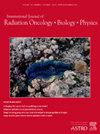标准护理机器学习前列腺放疗治疗计划的临床结果
IF 6.4
1区 医学
Q1 ONCOLOGY
International Journal of Radiation Oncology Biology Physics
Pub Date : 2024-10-01
DOI:10.1016/j.ijrobp.2024.07.017
引用次数: 0
摘要
目的/目标 机器学习(ML)放疗(RT)治疗规划在保证质量的同时提高了效率。然而,目前还没有将机器学习作为标准治疗方法来制定放疗计划的前瞻性患者疗效评估,因此限制了对其价值主张的评估。我们假设,在前瞻性应用过程中,ML 和人工生成的 RT 计划在泌尿生殖系统(GU)和胃肠道(GI)毒性方面的临床差异极小。材料/方法我们在 2019 年 11 月至 2022 年 6 月期间接受治疗的 113 例连续患者队列中,对 ML 和人工生成的治疗性前列腺 RT(60 Gy,20 次分次)计划进行了前瞻性评估。我们采用了此前由本机构开发、验证并在临床上实施的剂量预测 ML 模型,该模型在商用 RT 计划系统中运行。ML计划是所有病例的默认计划方法,无需任何手动调整。放射肿瘤专家要么批准 ML 计划,要么要求提供人类生成的替代计划进行直接比较,然后选择首选计划进行治疗。我们收集了所有患者至少 180 天的泌尿系统和消化系统毒性随访结果。我们对 ML 计划和人类生成计划的 2 级以上 GU 和 2 级以上 GI 毒性进行了无毒生存期 Kaplan-Meier 分析,并根据 log-rank 检验进行比较。在要求使用人工生成计划的病例中,只有一个病例选择了 ML 计划进行治疗。在治疗结果方面,没有观察到与治疗相关的 2+ 级消化道毒性,在无毒生存率方面,ML 计划与人类生成计划之间没有观察到 2+ 级 GU 毒性的显著差异(P = 0.39)。如果经过适当的验证和部署,ML 计划可以在提高效率的同时保持良好的临床效果,并且可以安全地用作适用于大多数患者的标准治疗方法,同时采用人工环路策略。本文章由计算机程序翻译,如有差异,请以英文原文为准。
Clinical Outcomes for Standard of Care Machine Learning Prostate Radiotherapy Treatment Planning
Purpose/Objective(s)
Machine learning (ML) radiotherapy (RT) treatment planning has shown improved efficiency while maintaining quality. However, there has been no prospective evaluation of patient outcomes when using ML as standard-of-care for RT planning, thereby limiting the assessment of its value proposition. We hypothesized that minimal clinical differences in genitourinary (GU) and gastrointestinal (GI) toxicities exist between ML- and human-generated RT plans during prospective application.
Materials/Methods
We prospectively evaluated ML- and human-generated plans for curative-intent prostate RT (60 Gy in 20 fractions) in a cohort of 113 consecutive patients treated between November 2019 and June 2022. We employed a previously institutionally developed, validated, and clinically implemented dose prediction ML model functioning within a commercial RT planning system. ML planning, without any manual adjustments, was the default planning method used in all cases. Radiation oncologists either approved the ML plan or requested an alternative human-generated plan for direct comparison, and then selected the preferred plan for treatment. GU and GI toxicities with minimum follow-up of 180 days were collected for all patients. We performed a toxicity-free survival Kaplan-Meier analysis for grade 2+ GU and grade 2+ GI toxicities between ML- and human-generated plans, and comparisons were based on log-rank tests.
Results
In the prospective standard of care ML deployment study, radiation oncologists selected ML plans for clinical treatment in 86 cases (76%) and selected human plans in 27 cases (24%). For cases in which a human-generated plan was requested, the ML plan was selected for treatment in only one case. In terms of treatment outcomes, there were no treatment-related grade 2+ GI toxicities observed and no significant differences in toxicity-free survival were observed for GU grade 2+ toxicities between ML- and human-generated plans (P = 0.39).
Conclusion
This is the first study demonstrating that dose prediction ML planning maintains low levels of toxicity in curative-intent prostate cancer and encourages the clinical translation of this technology into practice. When appropriately validated and deployed, ML planning can retain good clinical outcomes while improving efficiencies and can be safely used as standard of care applicable to the majority of patients, with a human-in-loop strategy.
求助全文
通过发布文献求助,成功后即可免费获取论文全文。
去求助
来源期刊
CiteScore
11.00
自引率
7.10%
发文量
2538
审稿时长
6.6 weeks
期刊介绍:
International Journal of Radiation Oncology • Biology • Physics (IJROBP), known in the field as the Red Journal, publishes original laboratory and clinical investigations related to radiation oncology, radiation biology, medical physics, and both education and health policy as it relates to the field.
This journal has a particular interest in original contributions of the following types: prospective clinical trials, outcomes research, and large database interrogation. In addition, it seeks reports of high-impact innovations in single or combined modality treatment, tumor sensitization, normal tissue protection (including both precision avoidance and pharmacologic means), brachytherapy, particle irradiation, and cancer imaging. Technical advances related to dosimetry and conformal radiation treatment planning are of interest, as are basic science studies investigating tumor physiology and the molecular biology underlying cancer and normal tissue radiation response.

 求助内容:
求助内容: 应助结果提醒方式:
应助结果提醒方式:


